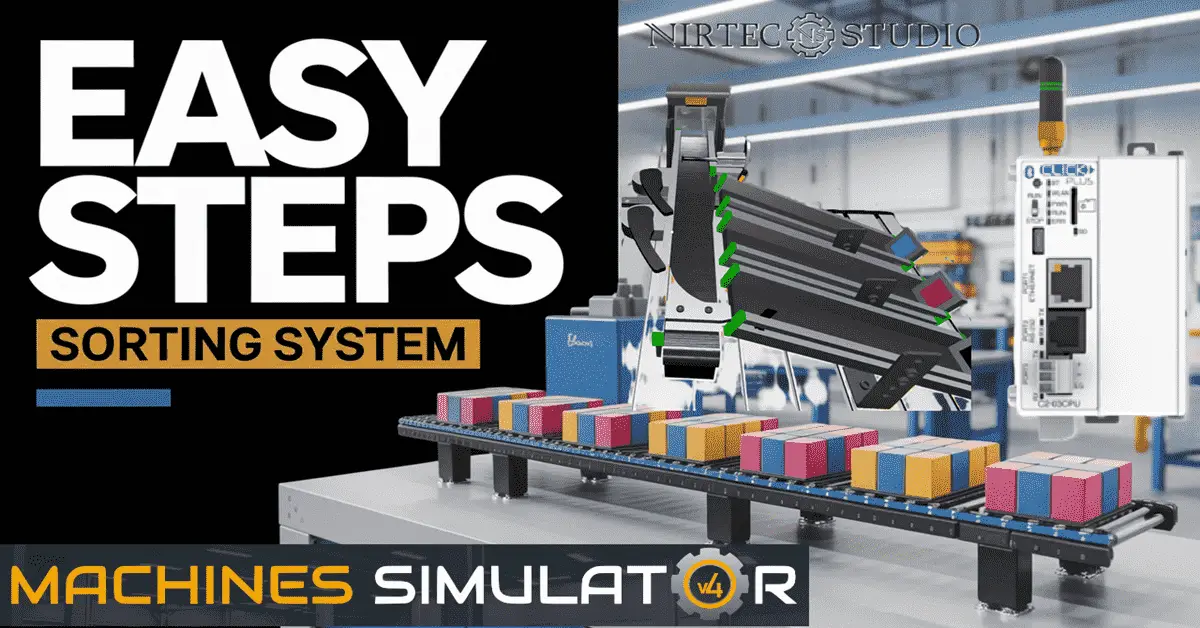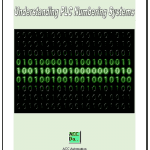Learn how to program a Click PLC sorting station from scratch in this comprehensive tutorial! We’ll take you through the step-by-step process of designing and programming a Click PLC sorting station, covering everything from setting up the PLC to writing the code. Whether you’re a beginner or an experienced programmer, this method is ideal for anyone seeking to enhance their PLC programming skills. By the end of this tutorial, you’ll have a solid understanding of how to create a functional sorting station using a Click PLC.
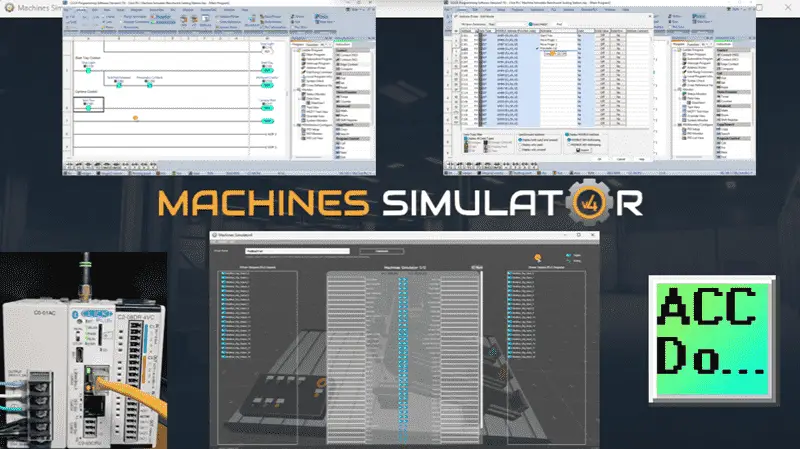
The Benchwork Sorting Station is just one of many machines in the Machine Simulator (MS), also known as EasyPLC. This sorting station features a camera that determines the color of the parts and directs them down one of three different ramps. Programming involves both automatic and manual modes, which are controlled from a push-button control panel. The Click programming software will be used to program this Click PLUS PLC.
Modbus TCP (Ethernet) will connect the Click to the Machine Simulator (EasyPLC). Discrete inputs and outputs will be controlled from the Machine Simulator (Client) to the Click PLC (Server). Using the five-step program development process, we will demonstrate how this sorting station is programmed. So, let’s get started and dive into the world of industrial automation programming!
Learn PLC programming the easy way. See below for a 10% discount on this cost-effective learning automation tool. Invest in yourself today.
Previously, we have done the following:
Easy PLC Installing the Software – Video
EasyPLC Software Suite – Quick Start – Video
Click PLC – Easy Transfer Line Programming – Video
Productivity PLC Simulator – Chain Conveyor MS – Video
Do-More PLC – EasyPLC Box Selection Program – Video
Click PLC EasyPLC Gantry Simulator – Video
Click PLC Simple Conveyor EasyPLC – Video
EasyPLC Paint Line Bit Shift – BRX Do-More PLC – Video
Click PLC – EasyPLC PLC Mixer Programming – Video
Click PLC EasyPLC Warehouse Stacker Example – Video
– Operation Video
EasyPLC Machine Simulator Productivity PLC Robotic Cell – Video
EasyPLC Simulator Robotic Cell Click PLC – Video
Palletizing Conveyor Programming Do-More PLC – Video
Palletizing Conveyor Programming – Click PLC – Video
Product Quality Verification! Do-More PLC Sequencer – Video
Revolutionize Learning PLCs with Pallet 3D Sim! – Video
Robot Packing PLC Program Development – Video
Box Dumper Easily Learn PLC Programming – Video
Innovative Solution for Mixing Ink and Bottling – Video
Benchwork 1 Do-More Practice PLC Programming – Video
LS Electric XGB PLC Easy Transfer Program – Video
Do-More PLC Automatic Robot Packing Machine – Video
Latest Machine Simulator Modbus Server Driver – Video
Machine Simulator Modbus Server to C-More HMI – Video
Creating the Ultimate Automation Training Setup
– Part 1 – Video
– Part 2 – Video
Unlock Click PLC & Machine Simulator Integration – Video
Master the Pneumatic Pusher Simulator Now! – Video
Define the task: (Step 1 – Click PLC Sorting Station)
The first step in developing a Click or any PLC program is determining what must be done. Start the Machine Simulator (MS). Select the machine’s button on the main page or select machines from the main menu at the machine simulator window.
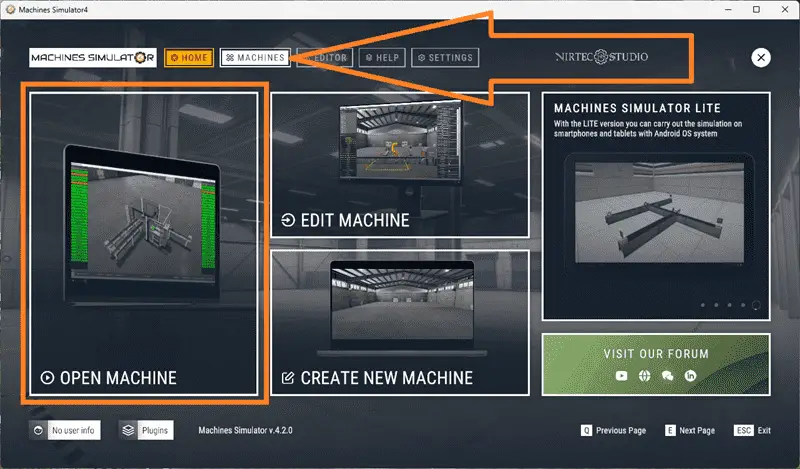
All available pre-built machines for practicing PLC programming will now be displayed.
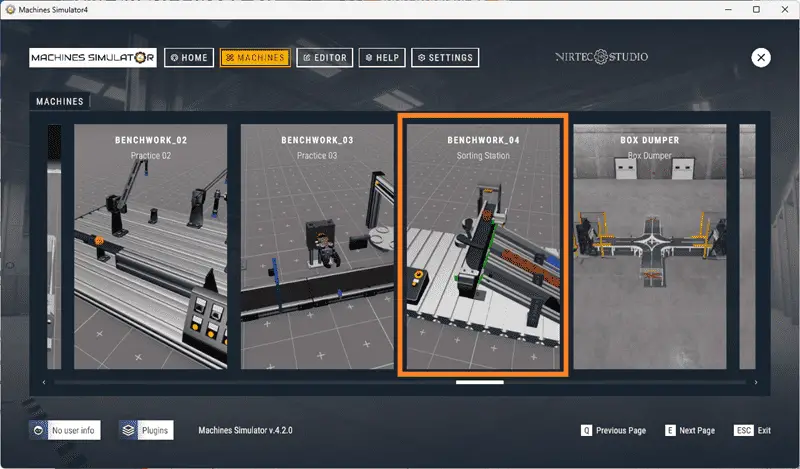
Move your mouse over the “Benchwork Sorting Station” machine. This is the machine that we will be programming. Three items will be displayed. Click the information button on the top right of the screen.
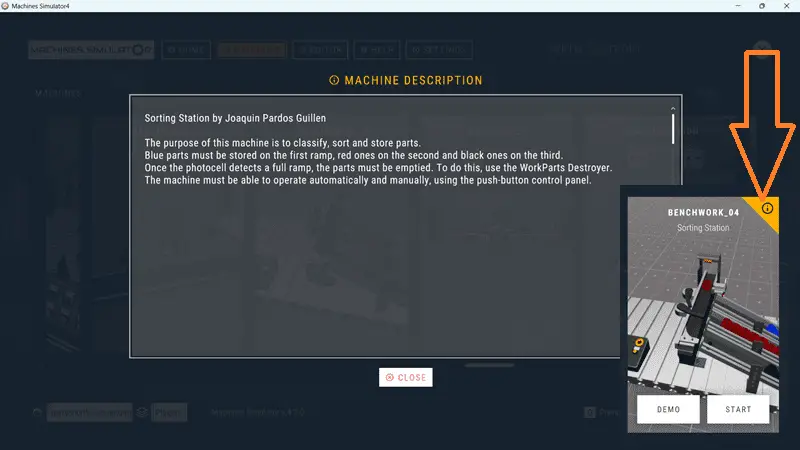
This will show you a description of the benchwork sorting station. Select Close.
The sorting station simulator has a demo mode. This will allow you to observe the machine’s operation, enabling us to understand the basics of how it functions. Select the demo mode for the benchwork sorting station.
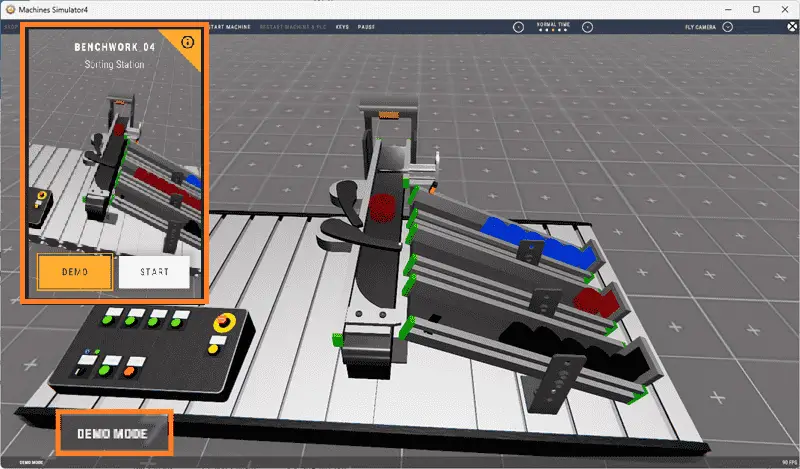
The demonstration mode will only show you the automatic mode. When the tray conveyor is in operation, a cylinder holds back that part, allowing the camera system to view it. Once the part is identified as either a Red, Blue, or Black part, the appropriate fingers will be set for the correct exit ramp. The cylinder is pulled back, allowing the part to move down the tray and be directed into the proper exit for the color. The cylinder is then extended to allow the next part to be identified.
There is a full sensor that covers all of the exit ramps. This will indicate when the part has been sent down the exit ramp. If the sensor is always on, then the exit ramp is full, and the parts must be removed.
Move around the 3D virtual environment.
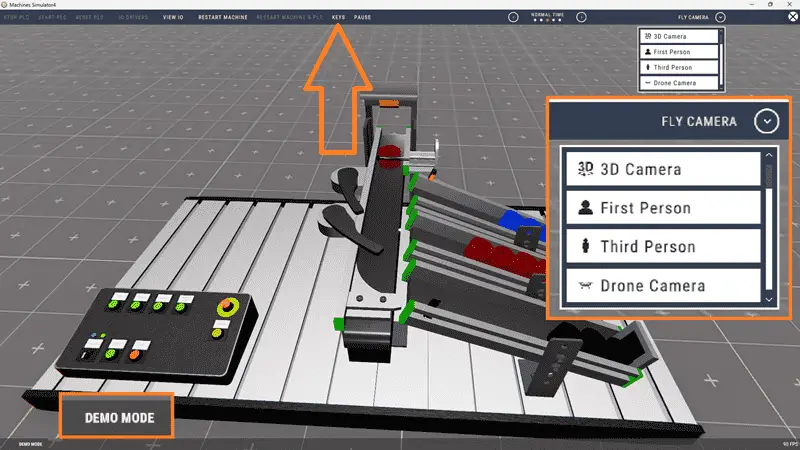
The icons at the top of the window enable you to navigate this 3D environment. The first icon is the default selection. This will allow you to move around without bumping into the components. The last icon will automatically show you around this virtual environment. The first-person mode will mimic a person in your 3D learning world. The third person will show you an operator and their relationship to the sorting station machine. Once we understand what needs to be done, we can proceed to the next step in developing the Click PLC program.
Watch the video below for a sequence of operations.
Define the Inputs and Outputs: (Step 2 – Click PLC Sorting Station)
At the top of the sorting station simulator window, the View I/O will display the inputs and outputs required for this example. The outputs are on the left-hand side, and the inputs are on the right-hand side.
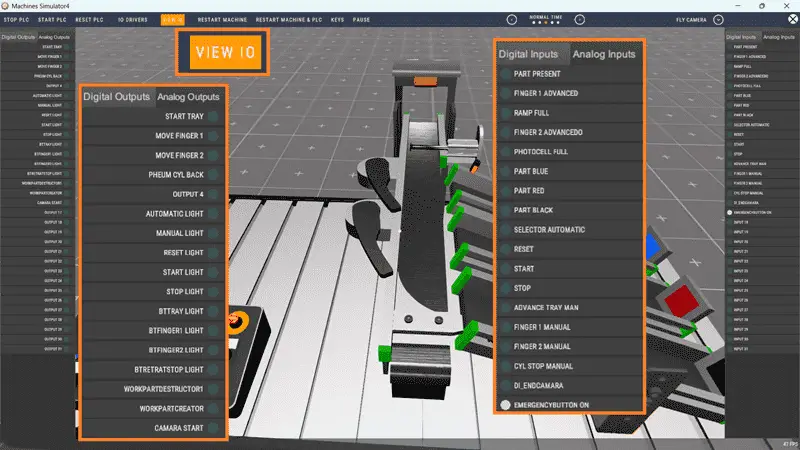
While still in demo mode, you can see the operation of the inputs and outputs.
The Benchwork Sorting Station Machine will require 17 digital outputs and 18 digital inputs. If you are unsure what the output or input is doing, start the sorting station in Start mode.
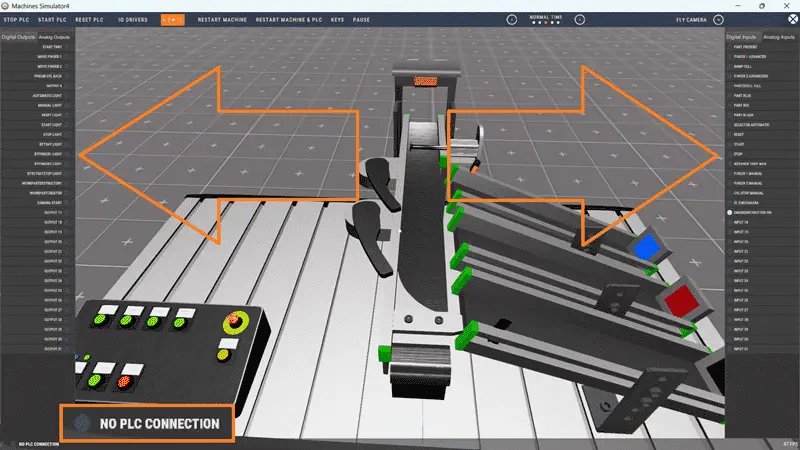
Select View IO at the top middle of the sorting station simulator window. We can manually run the Benchwork Sorting Station without a control system, such as a Click PLC.
Clicking on the outputs will allow you to turn them on manually. You can then monitor the inputs to see their operation. The restart button at the top of the machine simulator window resets the scene to its starting point. The following table defines the inputs and outputs (I/O) and Modbus addresses that we will use in the Click PLC for this program.
| Digital Type | Description | Click PLC Modbus Address | Machine Simulator Modbus Address |
| PLC Output – MS Input | Start Tray | 16485 – C101 | 16484 |
| PLC Output – MS Input | Move Finger 1 | 16486 – C102 | 16485 |
| PLC Output – MS Input | Move Finger 2 | 16487 – C103 | 16486 |
| PLC Output – MS Input | Pneumatic Cylinder Back | 16488 – C104 | 16487 |
| PLC Output – MS Input | Output 4 | 16489 – C105 | 16488 |
| PLC Output – MS Input | Automatic Light | 16490 – C106 | 16489 |
| PLC Output – MS Input | Manual Light | 16491 – C107 | 16490 |
| PLC Output – MS Input | Start Light | 16492 – C108 | 16491 |
| PLC Output – MS Input | Stop Light | 16493 – C109 | 16492 |
| PLC Output – MS Input | BT Tray Light | 16494 – C110 | 16493 |
| PLC Output – MS Input | BT Finger 1 Light | 16495 – C111 | 16494 |
| PLC Output – MS Input | BT Finger 2 Light | 16496 – C112 | 16495 |
| PLC Output – MS Input | BT Retract Stop Light | 16497 – C113 | 16496 |
| PLC Output – MS Input | Workpart Destruction | 16498 – C114 | 16497 |
| PLC Output – MS Input | Workpart Creator | 16499 – C115 | 16498 |
| PLC Output – MS Input | Camera Start | 16500 – C116 | 16499 |
| PLC Input – MS Output | Part Present | 16585 – C201 | 16584 |
| PLC Input – MS Output | Finger 1 Advanced | 16586 – C202 | 16585 |
| PLC Input – MS Output | Ramp Full | 16587 – C203 | 16586 |
| PLC Input – MS Output | Finger 2 Advanced | 16589 – C205 | 16588 |
| PLC Input – MS Output | Photocell Full | 16590 – C206 | 16589 |
| PLC Input – MS Output | Part Blue | 16591 – C207 | 16590 |
| PLC Input – MS Output | Part Red | 16592 – C208 | 16591 |
| PLC Input – MS Output | Part Black | 16593 – C209 | 16592 |
| PLC Input – MS Output | Selector Automatic | 16594 – C210 | 16593 |
| PLC Input – MS Output | Reset | 16595 – C211 | 16594 |
| PLC Input – MS Output | Start | 16596 – C212 | 16595 |
| PLC Input – MS Output | Stop | 165897- C213 | 16596 |
| PLC Input – MS Output | Advance Tray Manual | 16598 – C214 | 16597 |
| PLC Input – MS Output | Finger 1 Manual | 16599 – C215 | 16598 |
| PLC Input – MS Output | Finger 2 Manual | 16600 – C216 | 16595 |
| PLC Input – MS Output | Cylinder Stop Manual | 16601 – C217 | 16596 |
| PLC Input – MS Output | DI End Camera | 16602 – C218 | 16597 |
| PLC Input – MS Output | Emergency Button ON | 16603 – C219 | 16598 |
Note: The machine simulator will be offset by one on the Modbus Addresses.
We can use the Click PLC Software to view the address picker and determine the Modbus addresses required for the program.
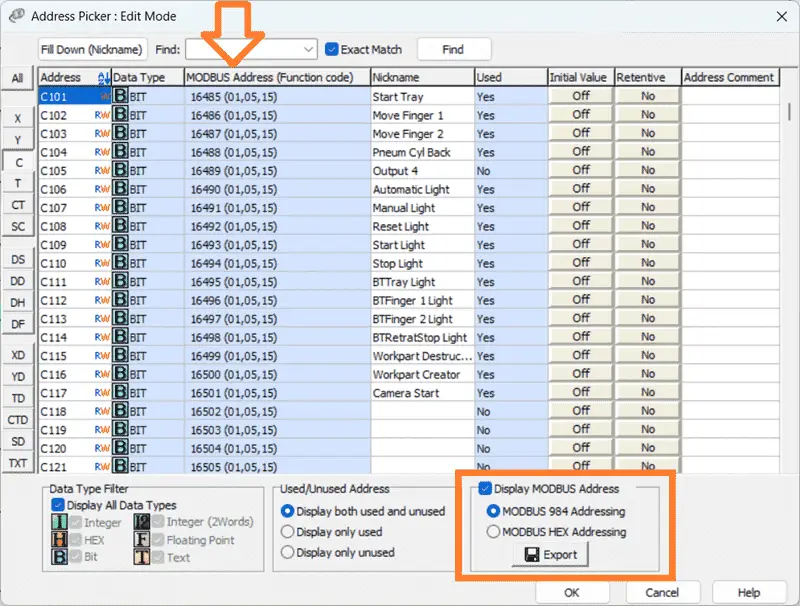
Develop a logical sequence of operation: (Step 3 – Click PLC Sorting Station)
A flow chart or sequence table is used to understand the process that needs to be controlled thoroughly. It must also answer questions like the following:
What happens when electrical power and pneumatic air is lost? What happens when the input/output devices fail? Do we need redundancy?
This step allows you to save yourself a lot of work by understanding everything about the operation. It will help prevent you from having to continually rewrite the PLC program logic. Knowing all of these answers upfront is vital in developing the PLC program.
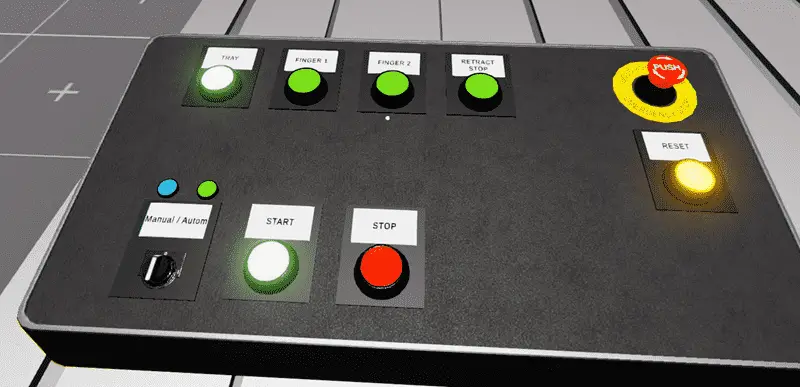
The push-button control panel of the Sorting Station program controls both automatic and manual movement. The operator will receive information on the machine’s status from the indicator lights. Conditions must be taken into consideration for all possibilities for switch and push-button inputs from the operator.
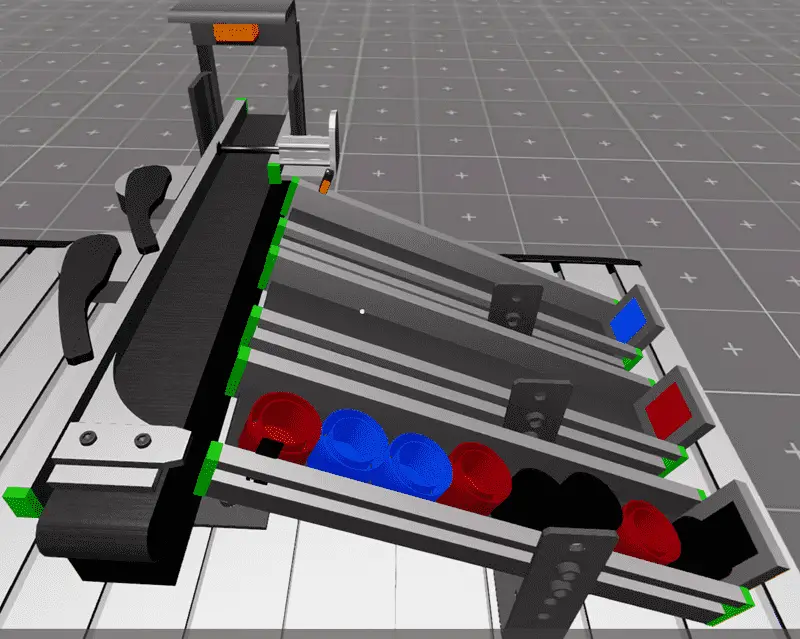
This is the hardest part of the programming development process. Getting all of the conditions down for each output based on the inputs is critical. Let me know if you agree in the comments below.
Our Sorting Station program can be seen as a simple conveyor operation. A part is read by a camera, which sets the color and presence of the part. The fingers are activated and confirmed. A cylinder will then allow the part to move down the tray and into the exit ramp. The full sensor will be used in conjunction with a timer to activate the part destroyer and automatically clear the exit ramps.
A PLC programmer must know everything about the sequence and operation of the machine before programming.
Ask questions or review existing documentation to ensure you understand the logical steps involved in the machine’s operation.
Develop the PLC program: (Step 4 – Click PLC Sorting Station)
Writing the ladder logic code for our Click PLC sorting station example will be the next step in our program development.
We will use the Click PLC programming software and a Click PLUS CPU. Call up the Address Picker from the Home tab. Select the display MODBUS option to see the addresses that will be used for our communication.
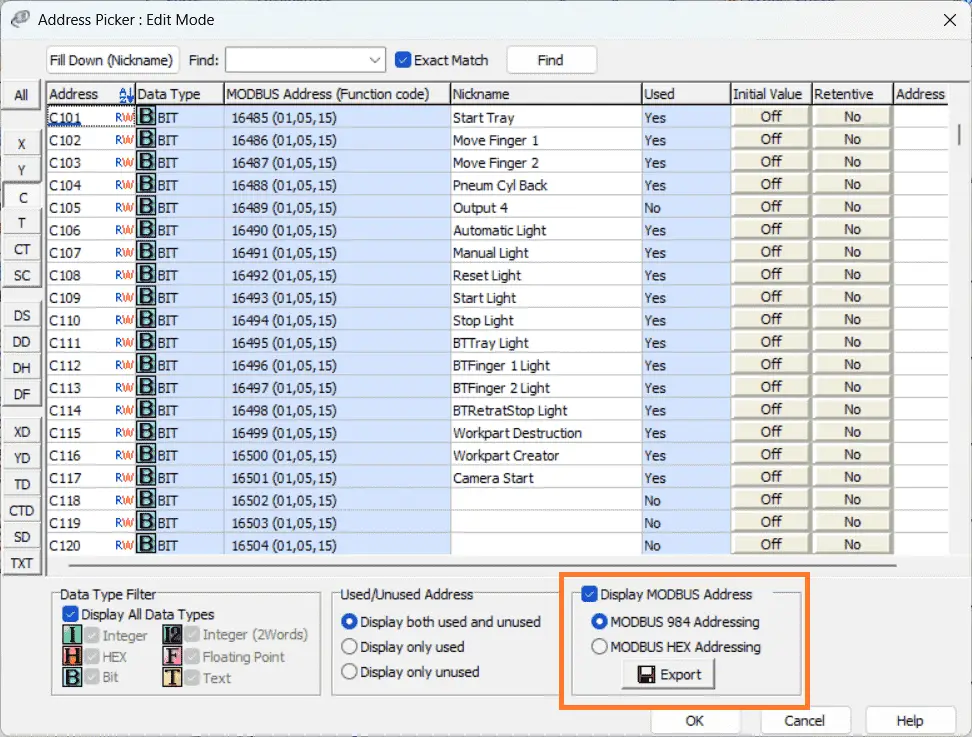
We can now enter the names for our inputs and outputs from the machine simulator for our sorting station.
Detailed information on the Click PLC can be found in our Click PLC Series. Our program will be written in ladder logic. (Ladder Diagram)
Do not worry that we do not document all of the names in our program. This can be added later as we need further variables in our program. Save and transfer our program to the Click PLC. It is good practice to save often during programming. This can save you a lot of time if the unexpected happens, such as a computer crash or a power outage.
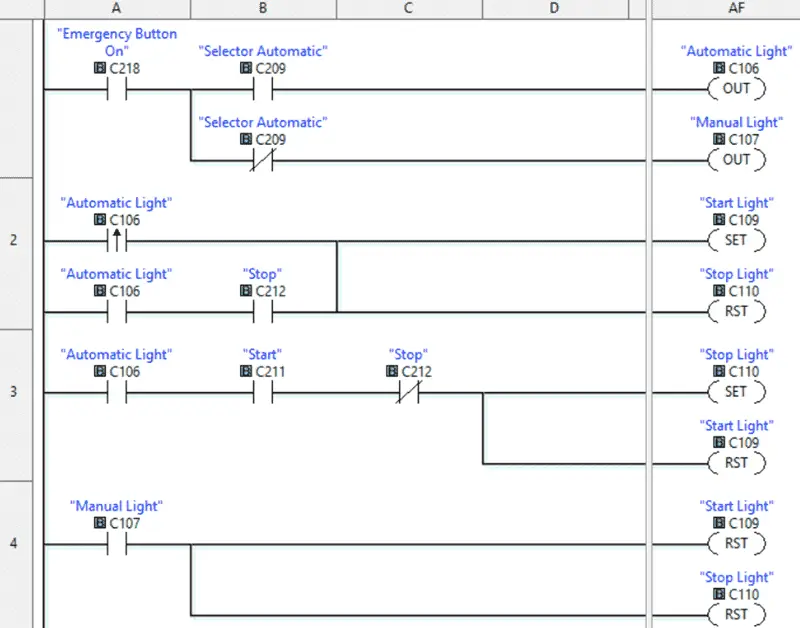
We will first program the lights on the push-button control panel. This will give the operator a visual indication of what the program is doing.
The emergency button input must be on for any light to be active. When the emergency button is activated, the automatic or manual lights will be turned on, depending on the setting of the selector switch.
The start and stop lights are only associated with the automatic mode. When the automatic mode is first turned on or when it is on and the stop input is activated, the start light will be on, and the stop light will be reset.
When automatic mode is selected and the start pushbutton is pressed, but not the stop pushbutton, the Stop Light will be active, and the Start Light will be reset. This indicates that the machine will be running. The stoplight indicates to the operator which button to use to stop the operation.
In manual mode, the start and stop lights are reset. Remember that the PLC will scan left to right, top to bottom. The reset from the manual will override any previously set condition.
Save and download the program into our Click PLUS PLC.
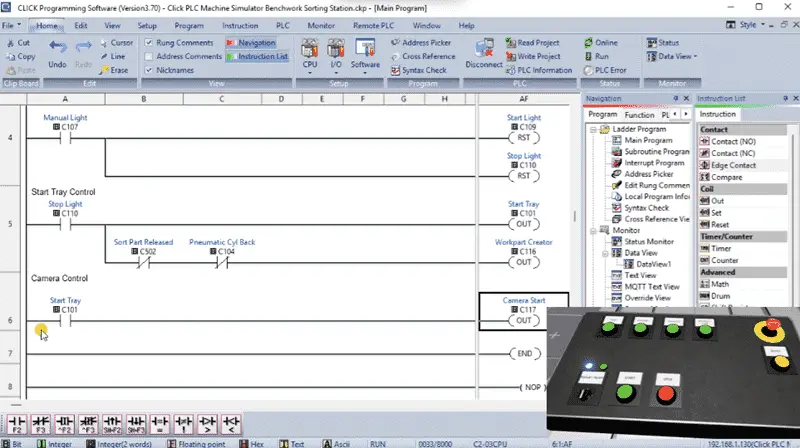
We will program the automatic sequence starting with the tray control. When we have the stoplight (Automatic Mode), the tray will start. If we do not have the sort part released and the pneumatic cylinder is back, then we will activate the create workpart.
The camera control will be activated when the start tray is on.
Save and download the program.

The finger control will determine which exit the part will take. If the stop light is on and the part is present, then, depending on whether the blue or red part is present, this will set finger 1 or 2. All of the parts will set the internal bit C501, indicating that a color part has been detected.
If we have detected the color part and the trailing signal from the ramp full sensor, this will reset the detected color part. Indicating that the part has been sent down one of the exit ramps. We will also rest both finger 1 and 2 outputs, and the sort part will be released.
The Sort Part Released will be set when the automatic mode is enabled and the color part is detected. The finger 1 and finger 1 advanced, or finger 2 and finger 2 advanced, or the black part will be placed in series before setting the Sort Part Released.
Save and download the PLC program.
Watch the video below to see the programming of this sorting station.
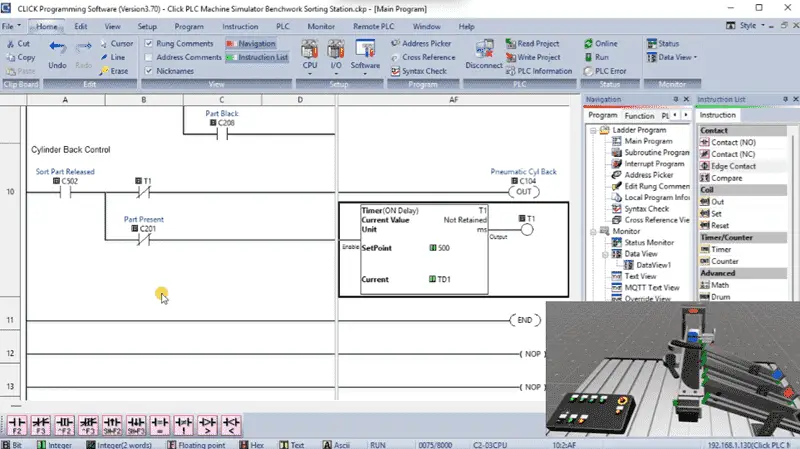
The cylinder back control will release the part to be sorted. If we have the Sort Part Release and not timer 1, then turn on the pneumatic cylinder. When the part is not present, then we will activate timer 1 for 500 milliseconds (0.5 seconds). This will release the part for sorting.
Save and download the PLC program.
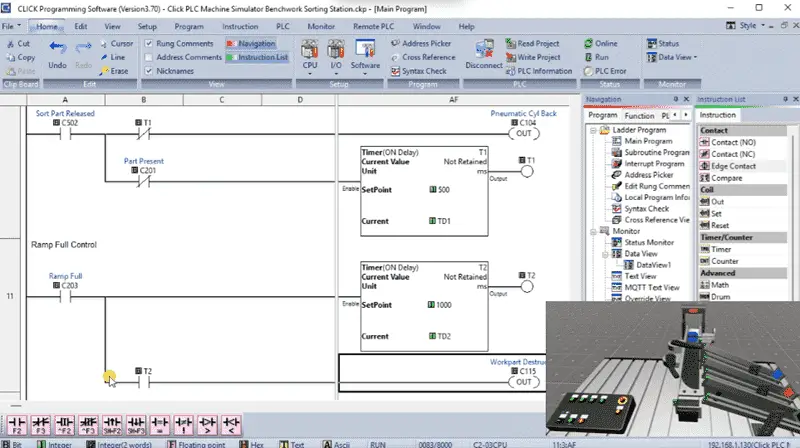
We will now program the Ramp Full Control. If the ramp full input is on for longer than 1000 milliseconds (1 second), then timer 2 will activate the workpart destroyer.
Save and download the Click PLC program.
Our automatic mode for our program is now complete.
We can now move on to the manual control.
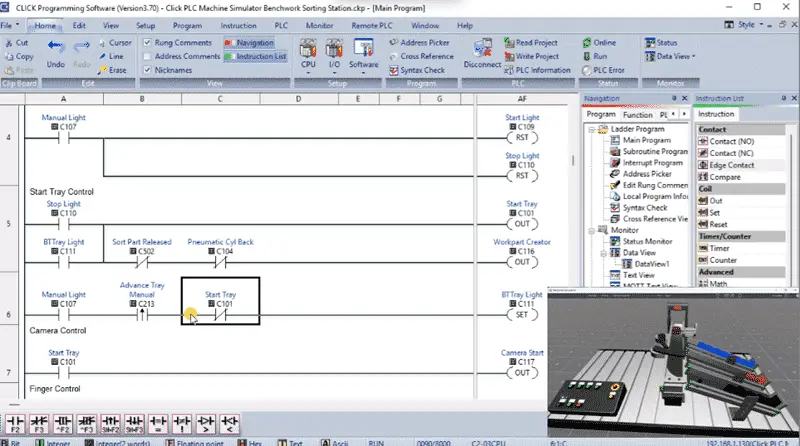
We will start with the tray control. If the manual tray light is on, then we will energize the tray.
The manual light will be set and reset based on the leading edge of the Advance Tray Manual pushbutton, and when the start tray is on or off. When we are not in manual mode, the light will be reset.
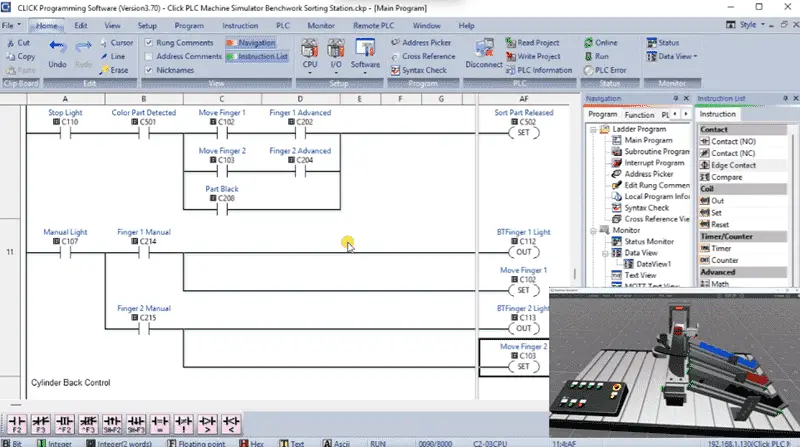
Finger control in manual mode will turn on the Finger 1 light and set the move finger to 1 when the Finger 1 manual pushbutton is selected. This will also happen with finger 2.
When not automatic, it will reset the automatic settings for the fingers.
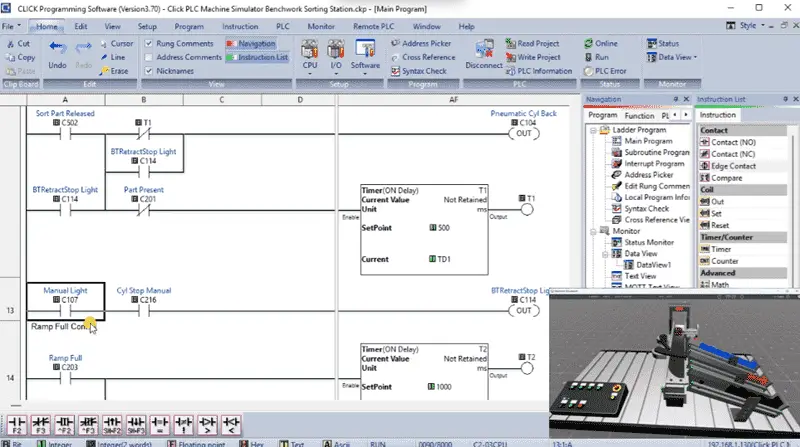
The cylinder back control will be activated with the manual pushbutton. This will also bypass the timer used for the automatic mode. The light for the cylinder back will be activated when the machine is in manual mode.
The reset pushbutton will turn on the light and activate the workpart destroyer. This will clear the machine ramps of the parts.
Save and download the PLC program.
Our program is now complete.
You can download this program below.
We communicate with the machine simulator using Modbus TCP (Ethernet or Wireless). The ports will be set up with a fixed IP address so the machine simulator (Modbus Client) can find the Modbus Server.
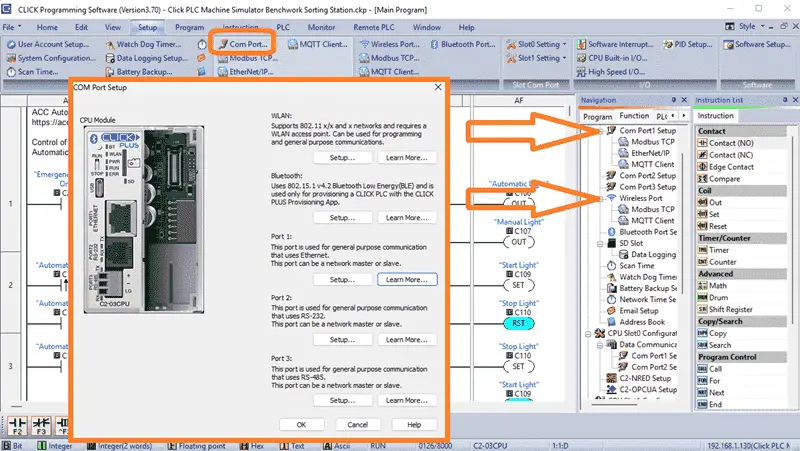
Select Modbus TCP from the communication port on the Function tab of the navigation window. You can also use the main menu | Setup | Com Port…
The COM port setup window will now be displayed. Click on the Setup Button for Port 1.
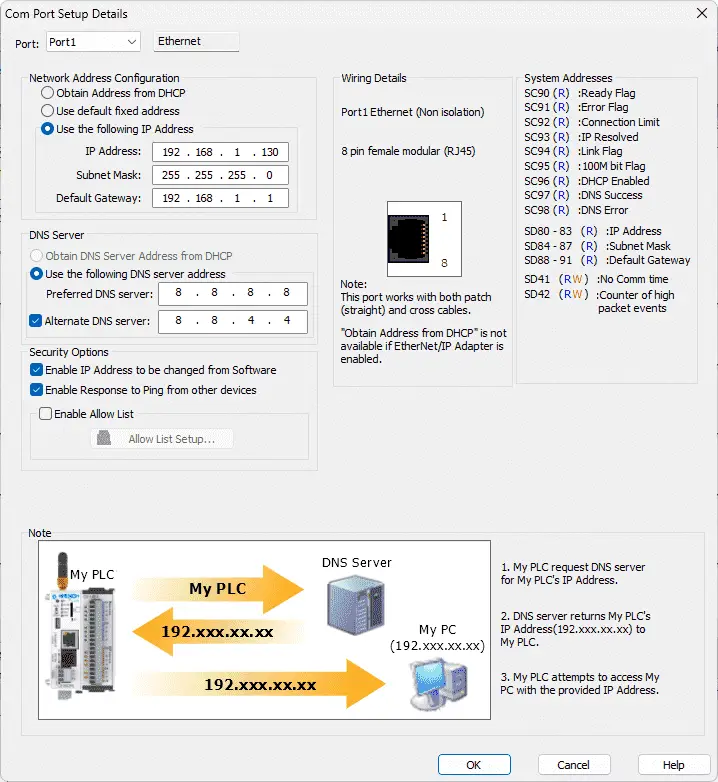
You can now set the static IP address on the Com Port Setup Details window. Make a note of the IP address. We will need this to connect to our Machine Simulator.
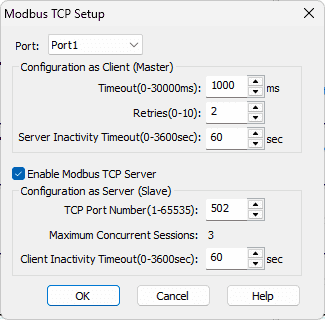
Select Modbus TCP Setup from the main menu | Setup. Ensure the “Enable Modbus TCP Server” is checked for our port.
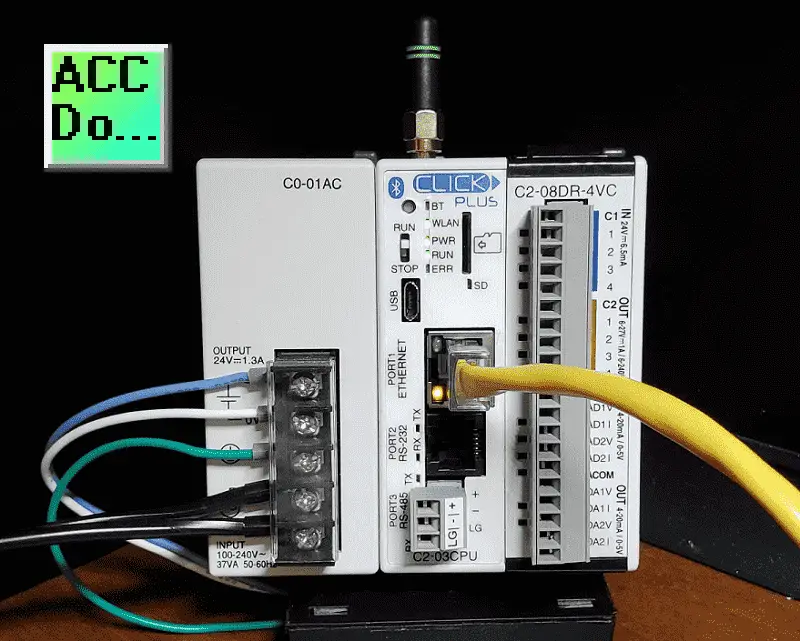
Ensure that the PLC is in run mode. Select “Status” to see the active status of the inputs and outputs on the ladder logic.
Test the program: (Step 5 – Click PLC Sorting Station)
We will use Modbus TCP on our Click PLUS PLC to communicate with the EasyPLC Machine Simulator. Call up the Benchwork Sorting Station in start mode.
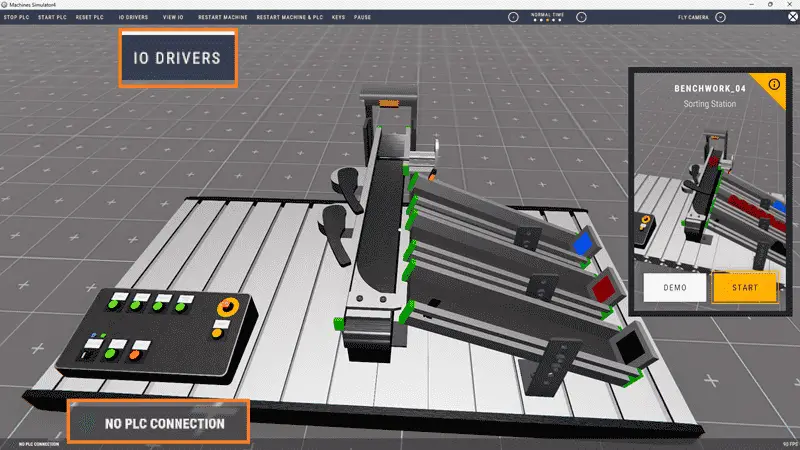
The status of the machine simulator will be at the bottom left of the screen. Currently, we have no PLC connected. Select IO Drivers at the top of the screen.

The machine simulator IO number will be displayed. Ensure we select more IO than required for our sorting station machine. The EasyPLC driver is selected by default.
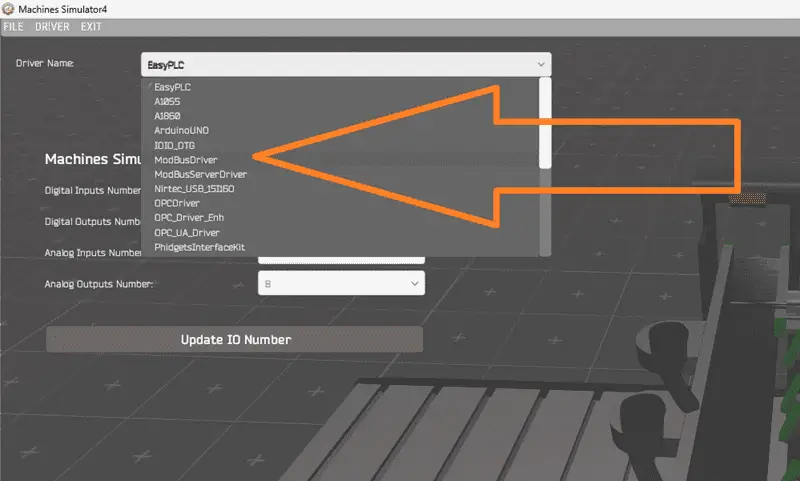
Under the driver pull-down menu, select “ModBusDriver.” This driver supports both Modbus TCP (Ethernet) and Modbus RTU (Serial) protocols. Select the down arrow on the driver’s name.
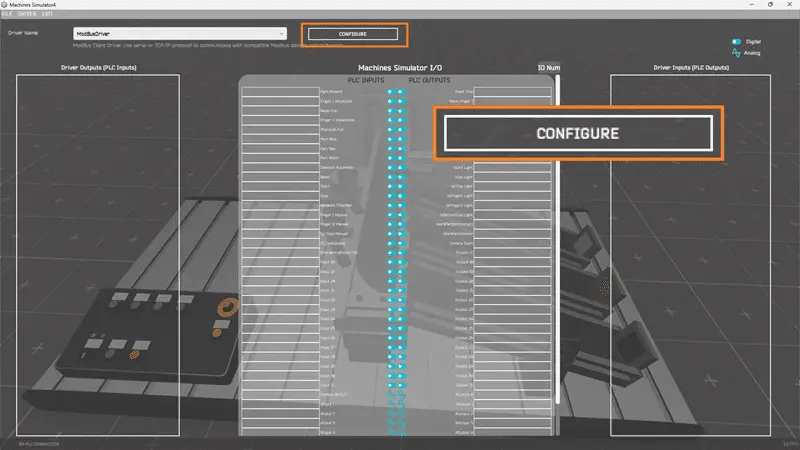
Select the configure button.
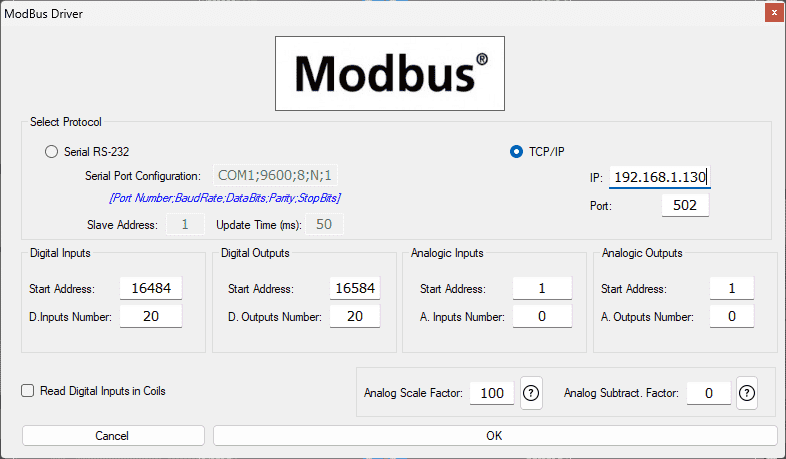
We can now enter the information for our Modbus driver. Select TCP/IP. This means the Ethernet port on the computer will communicate with the Click PLC. The digital inputs from MS to the Click PLC will be C101 to C118. This will start at address 16484 due to the offset of 1. Digital outputs from MS to the Click PLC will be C201 to C218. This will begin at address 16584 due to the offset of 1. Select the OK button.
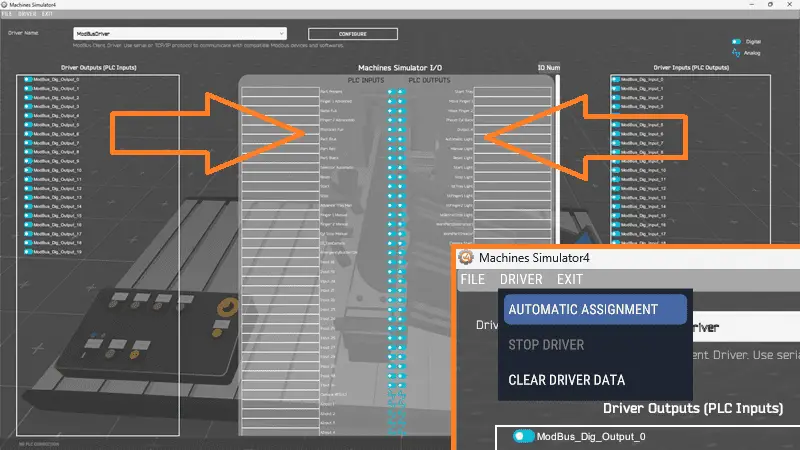
You will now see the inputs and outputs specified for the Modbus driver. We can now manually assign the driver outputs to the PLC inputs and the driver inputs to the PLC outputs. However, the automatic assignment works well and will save you time.
Select Automatic Assignment from the driver option in the main menu.
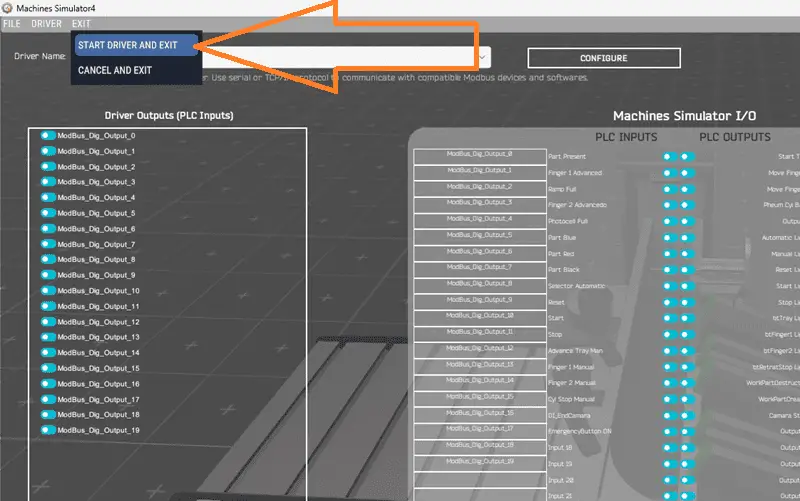
This will automatically assign the PLC IO to the Machine Simulator IO. Select Start Driver and exit from the main menu.
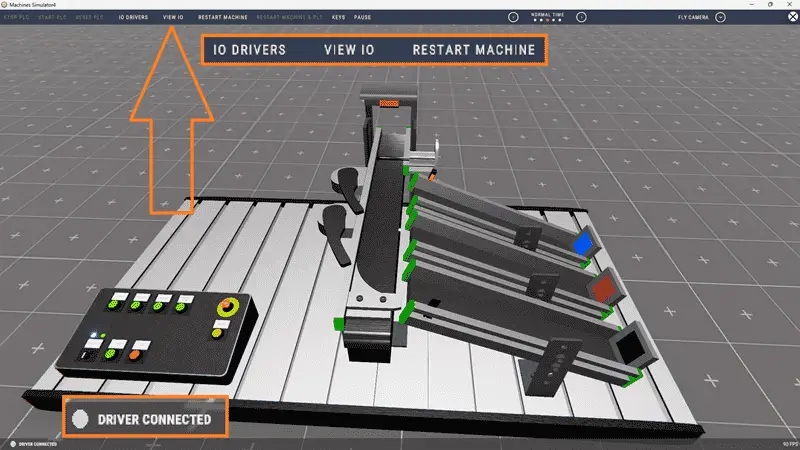
On the bottom left side of the window, the driver communicates with the Click PLUS PLC.
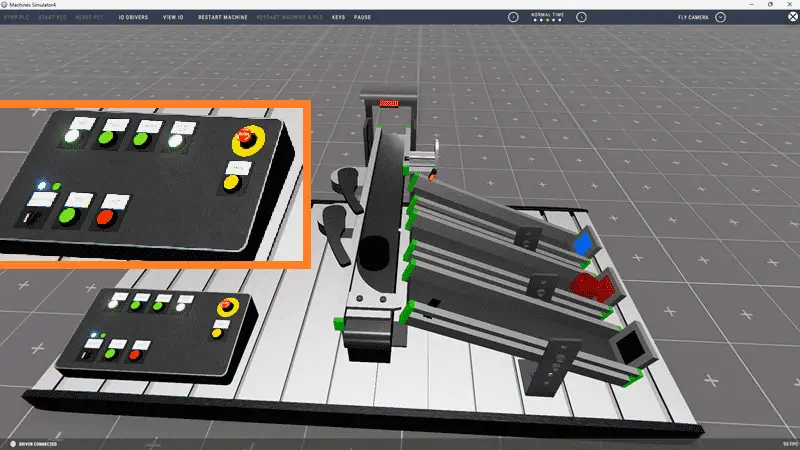
Ensure that the Click PLC is in run mode. We can see the operation of our sorting station machine. Try all of the manual operations from the pushbutton control panel.
Select View IO to know the input and output status of the machine simulator. Please select the automatic mode. Select the start pushbutton to start the automatic sorting machine.
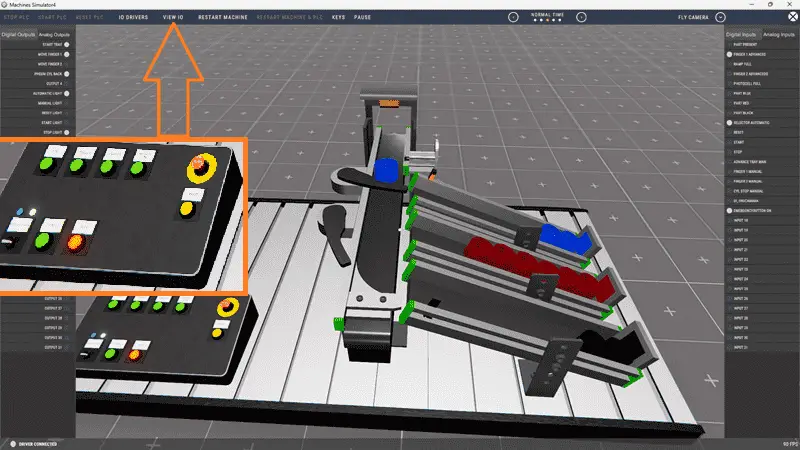
The digital inputs and outputs of the MS will correspond to the PLC controller.
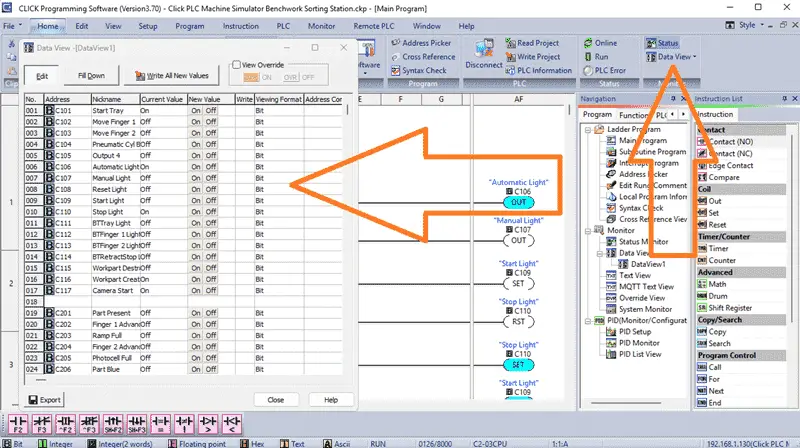
Using the Data View window of the Click programming software, we can also watch the input and output operations.
Using a Machine Simulator (MS) to test the program will ensure that our program works. Troubleshooting is quickly done without damage to any physical hardware.
You can practice your modification and debugging by modifying the sorting station operation in the following way:
– Utilize the Click Remote Mobile App to control this sorting machine. Additional internal contacts will need to be added to the program to control this from your phone.
– Add a counter for each of the exit conveyors. The counter will show the number of each color on the appropriate exit conveyor. The reset will also reset these three counters.
– Calculate the rate of the parts sorted per hour. This can be calculated in the PLC ladder logic during automatic mode.
Let me know how you make out in the comments below.
Download the Click PLC sample program here.
Watch the video below to see the five steps of program development applied to the sorting station machine. The machine simulator is one of the best applications to help you learn PLC programming.
Watch on YouTube: Master PLC Sorting Station Programming in 20 Minutes!
The Machine Simulator (EasyPLC) Software Suite is a comprehensive package that includes PLC, HMI, and machine simulator software. This PLC automation learning package includes the following:
Easy PLC – PLC Simulation allows programming in Ladder, Grafcet, Logic Blocks, or Script.
HMI System – Easily create a visual human-machine interface (HMI)
Machine Simulator – A virtual 3D world with real-time graphics and physical properties. PLC programs can be tested using EasyPLC or through other interfaces. (Modbus RTU, TCP, etc.)
Machine Simulator Lite – Designed to run on Android Devices.
Machine Simulator VR – Virtual Reality comes to life so you can test, train, or practice your PLC programming.
Purchase your copy of this automation learning package for less than USD 95 for a single computer installation or less than USD 110 to allow access on multiple computers.
Receive 10% off the price by typing in ACC in the comment section when you order. http://www.nirtec.com/index.php/purchase-price/
Learn PLC programming the easy way. Invest in yourself today.
If you have any questions or require additional information, please do not hesitate to contact me.
Thank you,
Garry
If you’re like most of my readers, you’re committed to learning about automation technology. The numbering systems used in PLCs are not challenging to understand. We will walk through them, including Bits, Decimals, Hexadecimals, ASCII, and Floating Points.
To get this free article, subscribe to my free email newsletter.
Use the information to educate others on how numbering systems work. Sign up now.
The ‘Robust Data Logging for Free’ eBook is also available for free download. The link is included when you subscribe to ACC Automation.

